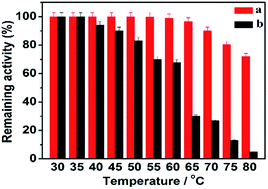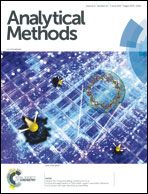Encapsulation of enzyme into mesoporous cages of metal–organic frameworks for the development of highly stable electrochemical biosensors†
Abstract
A water-stable metal–organic framework (MOF) [PCN-333(Fe)] with ultra-large cavities and ultra-high porosity was synthesized and employed to encapsulate horseradish peroxidases (HRP) for the fabrication of electrochemical biosensors. Due to the size-match of a HRP and large cage of PCN-333(Fe), encapsulation of enzyme into the PCN-333(Fe) was achieved. The prepared HRP@PCN-333(Fe) was characterized by XRD, SEM, confocal microscopy, N2 adsorption isotherms, UV-vis spectroscopy and circular dichroism. The analytical performance of the electrochemical biosensor based on the HRP@PCN-333(Fe) for the detection of H2O2 was investigated by cyclic voltammetry and amperometry. Encapsulation of HRP in PCN-333(Fe) presented a high enzyme loading and excellent electrocatalytic activity toward H2O2 reduction. An extended linear range from 0.5 μM to 1.5 mM with a low detection limit of 0.09 μM (S/N = 3) was obtained based on the biosensor. More importantly, the operational acid and thermal stabilities of the biosensor were significantly improved due to the HRP adsorbed on the surface of the support. These good properties are mainly attributed to the confinement of HRP in the cage of PCN-333(Fe), which not only essentially eliminates enzyme aggregation and leaching, and improves the catalytic efficiency, but also effectively hinders the conformational change of immobilized HRP when continuously used, or heated under acidic condition. As a result, the encapsulation of enzymes in the mesopore PCN-333(Fe) provides a new and excellent platform for the development of highly stable and sensitive electrochemical biosensors.



 Please wait while we load your content...
Please wait while we load your content...